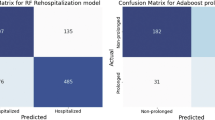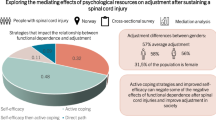Abstract
Study design:
Retrospective study.
Objective:
To compare the rehabilitation outcomes of non-traumatic and traumatic spinal cord injury patients.
Setting:
Spinal cord unit of a rehabilitation hospital in Italy.
Patients and methods:
In total, 380 patients at first rehabilitation stay after the lesion (144 traumatic patients and 236 non-traumatic patients; 244 men and 136 women; mean age 46.1±19.9 years; mean lesion to admission time 49.6±39.8 days).
Interventions:
Not applicable.
Measures:
American Spinal Injury Association standards; Barthel index (BI), Rivermead mobility index and walking index for spinal cord injury. Statistical analysis: Poisson regression models with relative risks and 95% confidence intervals adjusted for the following confounders: age, sex, lesion level and Asia impairment. Models were stratified by age because a strong interaction between different variables and age was found.
Results:
Traumatic and non-traumatic populations showed several significant differences with regard to age, level and severity of lesion. When adjusted for these factors patients with traumatic injuries showed a significantly lower BI score at admission and significantly better improvement in the BI score by discharge. The two populations were discharged with similar functional outcome. No significant differences were found with regard to the others outcomes.
Conclusions:
In clinically stable patients, spinal cord injury etiology does not seem to affect the rehabilitative prognosis. At admission, traumatic patients show lower autonomy in daily life activities, probably because of the associated lesions that these patients often have. At discharge, traumatic and non-traumatic spinal cord lesion patients achieved similar results with regard to neurological and functional improvement.
Similar content being viewed by others
Log in or create a free account to read this content
Gain free access to this article, as well as selected content from this journal and more on nature.com
or
References
Ditunno JF . The John Stanley Coulter lecture. Predicting recovery after spinal cord injury: a rehabilitation imperative. Arch Phys Med Rehabil 1999; 80: 361–364.
Scivoletto G, Morganti B, Ditunno P, Ditunno JF, Molinari M . Effects of age on spinal cord lesion patients rehabilitation. Spinal Cord 2003; 41: 457–464.
Consortium for Spinal Cord Medicine Clinical Practice Guidelines. Paralyzed Veterans of America: Washington, DC, 1999.
Sumida M, Fujimoto M, Tokuhiro A, Tominaga T, Magara A, Uchida R . Early rehabilitation effect for traumatic spinal cord injury. Arch Phys Med Rehabil 2001; 82: 391–395.
McKinley WO, Seel RT, Gadi RK, Tewksbury MA . Nontraumatic vs traumatic spinal cord injury: a rehabilitation outcome comparison. Am J Phys Med Rehabil 2001; 80: 693–699.
McKinley WO, Seel RT, Hardman JT . Nontraumatic spinal cord injury: incidence, epidemiology and functional outcome. Arch Phys Med Rehabil 1999; 80: 619–623.
Catz A, Goldin D, Fishel B, Ronen J, Bluvshtein V, Gelernter I . Recovery of neurological function following nontraumatic spinal cord lesions in Israel. Spine 2004; 29: 2278–2282.
Citterio A, Franceschini M, Spizzichino L, Reggio A, Rossi B, Stampacchia G . Nontraumatic spinal cord injury: an Italian survey. Arch Phys Med Rehabil 2004; 85: 1483–1487.
Ones K, Yilmaz E, Beydogan A, Gultekin O, Caglar N . Comparison of functional results in non-traumatic and traumatic spinal cord injury. Disabil Rehabil 2007; 29: 1185–1191.
Gupta A, Taly AB, Srivastava A, Vishal S, Murali T . Traumatic vs non-traumatic spinal cord lesions: comparison of neurological and functional outcome after inpatient rehabilitation. Spinal Cord 2008; 46: 482–487.
Osterthun R, Post MWM, van Asbeck FWA, . Characteristics, length of stay and functional outcome of patients with spinal cord injury in Dutch and Flemish rehabilitation centers. Spinal Cord 2009; 47: 339–344.
American Spinal Injury Association. American Spinal Injury Association: Chicago, 2000: 1–23.
Mahoney FI, Barthel DW . Functional evaluation: the Barthel Index. Mar State Med J 1965; 14: 61–65.
Collen FM, Wade DT, Robb GF, Bradshaw CM . The Rivermead mobility index: a further development of the Rivermead Motor Assessment. Int Disabil Stud 1991; 13: 50–54.
Ditunno JF, Ditunno PL, Graziani V, Scivoletto G, Bernardi M, Castellano V et al. Walking index for spinal cord injury (WISCI): an international multicenter validity and reliability study. Spinal Cord 2000; 38: 234–243.
Pagliacci MC, Celani MG, Spizzichino L, Zampolini M, Aito S, Citterio A et al. Gruppo Italiano studio epidemiologico mielolesioni (GISEM) group spinal cord lesion management in Italy: a 2-year survey. Spinal Cord 2003; 41: 620–628.
Calancie B, Molano MR, Broton JG . Epidemiology and demography of acute spinal cord injury in a large urban setting. J Spinal Cord Med 2005; 28: 92–96.
Chafetz RS, Mulcahey MJ, Betz RR, Anderson C, Vogel LC, Aughan JP et al. Impact of prophylactic thoracolumbosacral orthosis bracing on functional activities and activities of daily living in the pediatric spinal cord injury population. J Spinal Cord Med 2007; 30 (Suppl 1): S178–S183.
New PW . Functional outcomes and disability after nontraumatic spinal cord injury rehabilitation: results from a retrospective study. Arch Phys Med Rehabil 2005; 86: 250–261.
Granger CV, Dewis LS, Peters NC, Sherwood CC, Barrett JE . Stroke rehabilitation: analysis of repeated Barthel Index measures. Arch Phys Med Rehabil 1979; 60: 14–17.
Ditunno JF . Point of view. Spine 2004; 29: 2283.
Acknowledgements
No party having a direct interest in the results of the research supporting this article has or will confer a benefit on the author(s) or on any organization with which the author(s) is/are associated.
Author information
Authors and Affiliations
Corresponding author
Ethics declarations
Competing interests
The authors declare no conflict of interest.
Rights and permissions
About this article
Cite this article
Scivoletto, G., Farchi, S., Laurenza, L. et al. Traumatic and non-traumatic spinal cord lesions: an Italian comparison of neurological and functional outcomes. Spinal Cord 49, 391–396 (2011). https://doi.org/10.1038/sc.2010.85
Received:
Revised:
Accepted:
Published:
Issue date:
DOI: https://doi.org/10.1038/sc.2010.85
Keywords
This article is cited by
-
Reliability and validity of the international standards for neurological classification of spinal cord injury in patients with non-traumatic spinal cord lesions
Spinal Cord (2022)
-
Validation of a clinical prediction rule for ambulation outcome after non-traumatic spinal cord injury
Spinal Cord (2020)
-
Degenerative cervical myelopathy — update and future directions
Nature Reviews Neurology (2020)
-
Feasibility of predicting improvements in motor function following SCI using the SCAR outcome measure: a retrospective study
Spinal Cord (2019)
-
Is admission to an SCI specialized rehabilitation facility associated with better functional outcomes? Analysis of data from the Thai Spinal Cord Injury Registry
Spinal Cord (2019)



